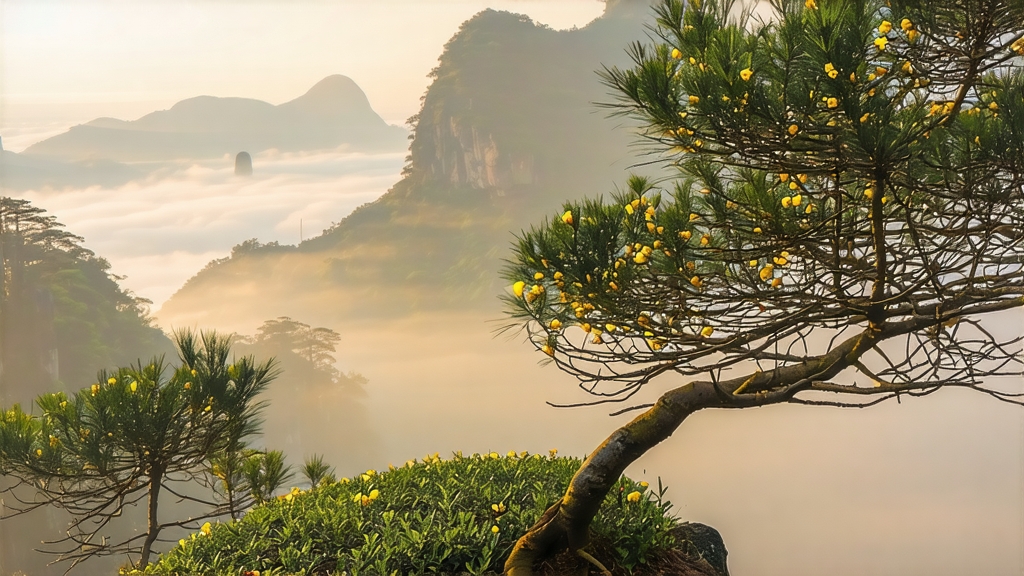
Tucked high on the mist-laced shoulders of Mengding Mountain in Sichuan Province, Mengding Huangya—literally “Yellow Bud from Mengding”—was once the first tea to reach the lips of emperors each spring. Today it remains one of China’s rarest and least-understood yellow teas, a category whose very existence hinges on a single, almost alchemical step called “sealed yellowing.” For international drinkers accustomed to the green flash of Dragon Well or the dark drama of Pu-er, Mengding Huangya offers a quieter revelation: a liquor the color of morning sunlight on bamboo, a fragrance that hovers between fresh chestnut and warm orchid, and a finish so clean it feels like breathing cloud.
History: From Imperial Tribute to Hidden Gem
Mengding Shan has been cultivated since the Western Han Dynasty (206 BCE – 9 CE). The Daoist master Gan Zhongchang is said to have planted the original seven tea trees on the summit as early as 53 BCE, making the mountain arguably the birthplace of cultivated tea in China. By the Tang Dynasty (618-907), Mengding teas were already tribute items, but the yellow variant—created by deliberately prolonging the leaf’s slight oxidation—was not documented until the late Ming. Carried in bamboo-lined chests down the Min River to Chengdu, then by imperial courier along the post-roads to Beijing, the buds arrived still fragrant with mountain mist. The last emperor to receive Mengding Huangya was Puyi in 1908; after the fall of the Qing, the technique drifted toward extinction, preserved only by a handful of monks and one resilient family line in Ya’an. Rediscovered in the 1970s during a national tea survey, the cultivar was revived using cuttings from those original summit trees, now protected as living monuments.
Terroir: Why the Mountain Makes the Bud
Mengding rises to 1,450 m where the Sichuan basin meets the Tibetan Plateau. Warm, moisture-laden clouds collide with cold Himalayan air, creating an eternal spring of fog and drizzle. The average annual humidity hovers at 85 %, UV exposure is softened, and diurnal temperature swings slow the growth of the leaf, stacking amino acids—especially L-theanine—into every bud. The soil is a crumbly, slightly acidic purple sandstone rich in selenium and zinc, minerals that translate into the tea’s signature sweetness. Only the fog-zone between 800 m and 1,200 m is deemed worthy for Huangya; above that, the leaf is too sparse, below it, too coarse.
Raw Material: One Bud, One Leaf, One Standard
Picking begins when the mountain azaleas bloom—usually the first ten days of April. Workers climb before dawn to catch buds at “fish-hook” stage: still curled like a tiny comma, 15–20 mm long, carrying a single just-unfurling leaf. The standard is merciless: 8,000 such sets yield barely 500 g of finished tea. No mechanical shears are allowed; fingernails must not bruise the tender stem. Leaves are placed in shallow bamboo baskets lined with fresh fern fronds to keep them cool during the two-hour descent to the village workshop.
Craft: The Art of “Men Huang” – Sealed Yellowing
Yellow tea’s identity rests on a step absent in green, black, or oolong processing: men huang, literally “sealed yellowing.” After a brief withering (30 min) the buds are wok-fired at 180 °C for three minutes, just enough to kill the green enzymes without driving off moisture. While still warm, they are wrapped in thick parchment paper and placed inside a bamboo steam chamber kept at 28 °C and 75 % humidity. There the leaf sleeps for 70–90 minutes, slowly suffocating and re-breathing its own aromatic vapors. Chlorophyll degrades into pheophytin, catechins oxidize just enough to round the edges, and a faint golden hue appears at the tips. The bundle is opened, gently rolled for thirty seconds to shape the fish-hook, then wrapped again; the cycle is repeated three times. Finally the leaf is dried in three stages: charcoal basket (60 °C), low oven (50 °C), and a finishing fluff at 40 °C until moisture drops to 5 %. The entire choreography spans 36 attentive hours; one mistimed hour and the lot reverts to green tea.
Grades & Styles
- Summit Huangya – picked from the original